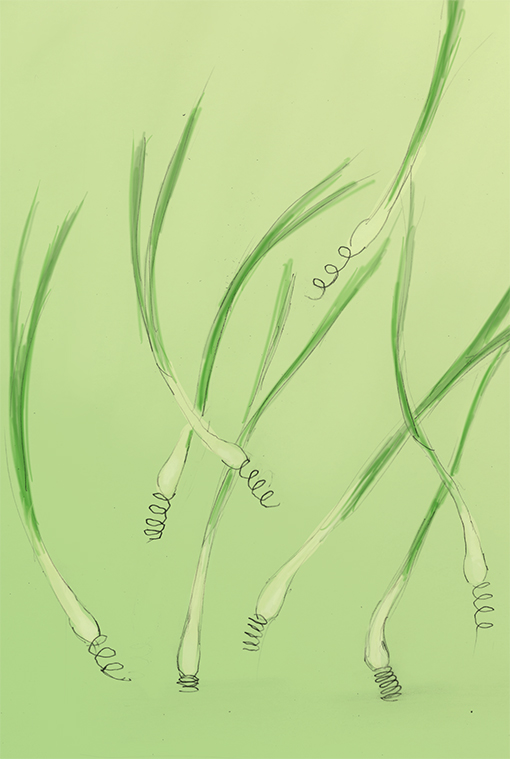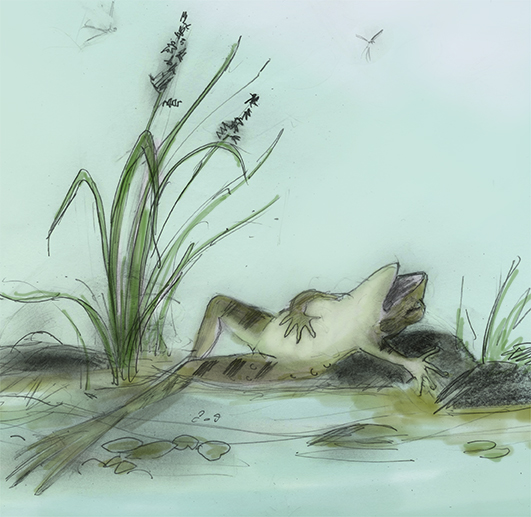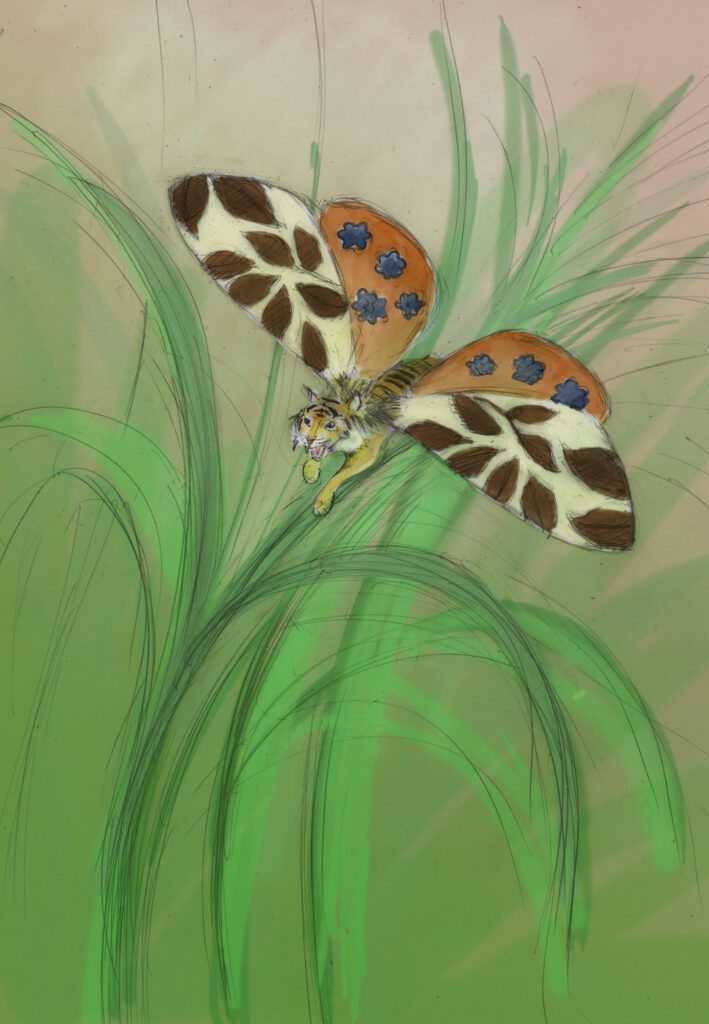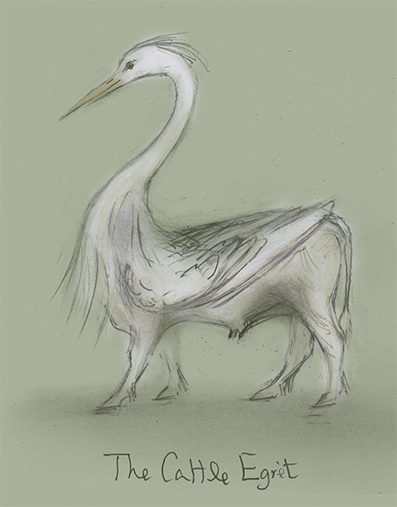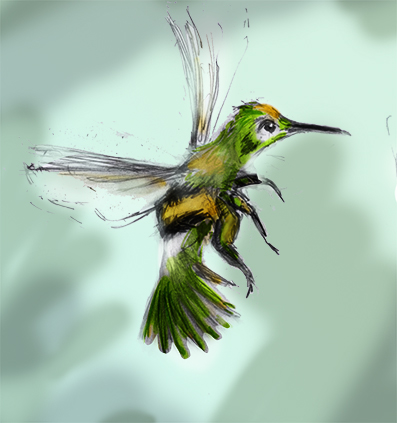I wrote this in 2015.
Chapter 7: Drawing the Illusion of Movement
Drawing Movement
Since 1975, when I started to go drawing at the Dance Centre in Covent Garden, I have spent many thousands of hours trying to capture the graceful movements of ballet dancers.
The next series of visual grammar posts will be about drawing movement. We will start by looking at the ways moving objects appear to change shape in unexpected ways and how knowledge of why these illusion happen can help us capture these movements in our drawings.
Shape Changing
I always understood that the movements I was trying to capture with a pencil and paper are not the same as those seen in a still photograph. There is a simple schoolboy trick to demonstrate this; when you wave a wooden ruler between a thumb and forefinger the ruler appears to be made of a bendy substance. I have made a drawing of this bendiness illusion.
My friend Alberto has kindly prepared a video of a chopstick being waved to show that when a rigid stick is waved it appears to be made of a bendy substance.
but when you freeze frame the video you will see the reality is of an unbending ruler in mid-flight.

and if the video is restarted the bendiness illusion starts up again. This proves to us that the shape changing is happening in our minds. Conclusion: When rigid structures move they appear to become squashy-stretchy-bendy, but this is only happening in the privacy of our subjective thoughts.
Flash Lag
There is a well known illusion called Flash Lag. Alberto has helped me construct this video to show the flash lag effect. The video is set up so that a yellow flash-dot occurs as the circling black dot passes the twelve o’clock position, like this:
but when we watch the video we see something different. As you run the video focus your eyes on the centre cross:
This is what we appear to see:
The flash-dot appears to light up after the circling dot has passed the twelve o’clock position. Events that happened simultaneously in the real world are not happening concurrently in our vision. The timing of the flash lags behind what happened in reality. The illusion demonstrates that Time is a construction of the mind, we call this brain activity “Time Perception” or “Temporal Perception”.
Time Perception – How it works (This section is complex; the best approach is to let the ideas wash over you and not to worry about understanding everything in detail!) There are many explanations of how simultaneous events in the real world lose their synchrony whilst being processed in the body and brain. To pick just one obvious (physiological) reason you need to imagine you are watching a nurse putting a bandage on your foot. Whilst you are watching her touch your foot you are also experiencing the sensation of the nurse’s hands touching your foot. The two sensations, seeing and feeling happen concurrently, or do they? The touch stimuli are carried by very long thin neurones that transmit pulses at quite slowly compared to the stimuli travelling along shorter super-highways between the eyes and the brain. It is an obvious fact that the touch stimuli arrived at the brain well after you saw the nurse touch your foot, but the brain unifies these two disjointed sensations into a single sensation. How does the brain unify simultaneous events that have become out of sync in the brain?
David Eagleman, who runs a laboratory dedicated to Time Perception, has demonstrated that if you look for “Temporal Illusions” they will pop up all over the place. This Wikipedia page has a selection of Temporal Illusions. Eagleman has written this short lucid summary of how he thinks the mind constructs Time Perception.
Eagleman asks us to envisage that our Subconscious thoughts are dispersed across the brain and happening at differing speeds in a sort of multi-verse multi-time environment, in contrast on a higher level we have a Self-aware Conscious Mind that uses unified time. The Self Aware Conscious Mind is slower and running a few hundred milliseconds behind the Subconscious mind. The Subconscious Mind provides the Conscious Mind with a version of events that is unified in time by a Master Clock.
Eagleman’s model proposes that whilst we might feel we are living in a river of consciousness we are in reality living in a river of past of experiences. Our Conscious minds are re-living events that have already finished happening in the subconscious part of the mind. The Master Clock is really a Was Clock (my term). This Model, which proposes that everything has happened before we become aware of it, appears to have no place for Free Will, but this view is to misunderstand how Free Will operates. The Conscious mind, which uses the Master Was-Clock, can assess the past activity of the super fast Subconscious Mind and then overrule/replace/control the way they are working. For instance when we step on a piece of green rope in the grass an alarm is set off by the super fast unconscious mind; our hearts start racing and we are petrified, then the slower concious mind assesses it was not a snake and our free will assist us in calming the heart and stabilising our emotions.
Our super fast subconscious minds are designed to work without a Master Was-Clock, they work with the raw unsynchronised information as it arrives. The subconscious mind does however still need to synchronise cause and effect. Eagleman demonstrates that there are Tidying-Up Clock(s) which constantly measure and remember the time differences between cause and effect of individual tasks. The Tidying-Up Clocks measure the misalignment between cause and effect, and these measurements are automatically included in the unified model of Time Perception that is later used to construct the Master Was-Clock.
A primary function of the brain is to predict cause and effect and to provide sensible responses. For instance cause and effect tasks we do in the physical world are constantly being measured and calibrated in the subconscious mind, for such tasks as how hard to push your foot down on the brake pedal to stop the car gently. If the worn out brake pads were secretly changed whilst you were sleeping you might be caught out in the morning and push too hard, but after just a few experiences your subconscious mind would re-calibrate your driving skill to include the effect of the new brake pads, and predict exactly how much pressure the pedal needed to give you and your passengers a smooth ride. Every super-fast subconscious reaction takes time to happen, so even the simplest everyday actions such as pushing a pedal or grasping a moving object, require highly sophisticated prediction and calibration machinery.
Fifteen years ago neuroscientists were dumbfounded by a simple demonstration called the The Rubber Hand Illusion which showed how fast and easily the subconscious mind is willing to recalibrate it’s senses. It demonstrates that it takes only a few seconds and a few strokes on a hand to convince the mind to adopt a rubber glove as belonging to its own body; in this video you can see this unbelievable willingness at work.
David Eagleman, as part of his research into Time Perception, set up a test where a small delay of .2 seconds was interceded between pressing a button and a light bulb coming alight. At first the subjects noticed the delay but after a while they felt there was no lag between the cause (pressing the button) and effect (light coming alight). The test showed how the mind was willing to recalibrated it’s construction of Time Perception in order to unify the two sensations into a single sensation
Then Prof. Eagleman removed the delay to zero and his subjects told the instructors that the light came on before they had had time to press the button, this happened because the mind got the order of events the wrong way round. This sensation would gradually disappear after the subject had pressed the button a few more times. Returning to our case of watching a Nurse touch our foot, the Tidying Up Clock has assessed that there will always be a time delay between the two sensations (seeing and feeling). This information has been used to calibrate the subconscious Mind which unifies the two sensations into a single experience for the Master Was-Clock . When we watch the nurse we feel that the cause (seeing her hand touch your skin) and effect (feeling her touch your skin) happen simultaneously (even though the brain experienced a lag between the two sensations)
Motion Blindness
If Time Perception is a construction of the mind, how about Motion? Is our perception of Motion a construction too? This insight that Motion is a Perception is confirmed by a condition known as “Akinetopsia” or “Motion Blindness”, a condition that can be induced by drugs or in rare cases happen to people with lesions in their brains. These unlucky people lose their ability to see objects move. In one case study, a patient called LM described pouring a cup of tea or coffee as difficult “because the fluid appeared to be frozen, like a glacier“. She did not know when to stop pouring, because she could not perceive the movement of the fluid, but she could see that the cup had got fuller.
There are illusions you can try that have the reverse effect to Motion Blindness. This Waterfall illusion induces you to see static images move. You can see the movement but you are aware that nothing on the picture is moving
And here is a static image that just won’t keep still, but I believe it might be a physiological response that has to do with Saccades rather than the subconscious.
The Subconscious Mind
Many of us think of our Subconscious mind as being a dark place. Perhaps we fear the unknown, perhaps Freud instilled in us a belief that it is place where our wickedness and fears reside? In the model we are engaging with drawing the subconscious is a Multi-verse with Multi-Time that knows no logic. It comes to the world as an innocent, it is designed to be accommodating and plastic so that it can envelop new ideas however crazy. It is a world where imagination is not confined by logic or objective truth
French 14th Century
Although we cannot directly know its workings it is a world well known to us because we are already living most of our lives there, we know it through metaphors of language, dreams, fantasies, poetry and Art. In the Subconscious no idea is censored or too difficult to accept, this willingness to envelop crazy concepts is the design feature that makes our minds flexible enough to see or imagine things we have never seen before
but the subconscious mind will build memories of associations between objects and emotions. Perhaps this is what upsets us. In the Subconscious mind everyday objects will often stimulate strong emotions: fear, love, anger, lust, certainty and doubt. Again these are features that were put there by evolution to make our minds able to deal with everything that the World throws at us. None of this is reason to fear our subconscious.
How Conscious and Subconscious Responses are Generated in our Minds
I expect you are confused. I have made this simplified diagram to show how I think our Subconscious and Conscious thoughts are related
Windows into the Mind
A well constructed Photograph can capture exquisite dance movements of extraordinary beauty, but the photograph will always the record the Real World which is different from the time warped multi-verse of our Subconscious Minds. The net result is that the photographic image will always be different from how a member of the audience experiences the dance movement whilst watching a live performance on stage.
Natalia Makarova There is one sort of camera that can reproduce the Flash Lag illusion, that is the video camera. In this video you can view Natalia Makarova using the properties of the Flash Lag Bendiness effect to enhance her swan-like arm movements; the illusion makes her arms appear to be more flexible and fluid than they are in real life.
Natalia Makarova Swan Lake Act 1 Royal Opera House
Animators Know how to Handle all this Stuff?
When artists make drawings of movement they are recording the experiences they felt they saw in their minds and feeding them back into the brains of their audiences. Animators are movement experts, so it is informative to examine their tried and tested knowledge of how to reconstruct our subjective experiences of Vision, Time Perception and Motion Perception.
Below is a page ofPreston Blair’s (1908 – 1995)instructions for animators. Animators call this shape changing technique “Stretch and Squash“. At the apex of the cycle, when the ball is momentarily static in the air, the ball is round, as it builds up speed on its descent it elongates, when hits the ground the animator exaggerates the squash. On the same page Mr Blair applies these Stretch and Squash illusions to how he treats figures.
Instructions by legendary Disney animator Preston Blair (1908 – 1995)
I followed Preston Blair’s Stretch and Squash instructions to make this video of a bouncing ball (lower tier). For comparison’s sake I also made the same video with a perfectly round ball (upper tier).
If you watch carefully you will see that both balls change shape. In the top tier video, where I made no shape changing to the perfectly round ball, the ball appears to slightly change shape because we experience the flash lag effect whenever we watch a real ball in motion. In the lower tier video I have changed the shape of the ball as per Preston Blair’s instructions and the ball changes shape in an exaggerated way, this over-emphasises what happens in real life.
People may wonder why Preston Blair wants to exaggerate bendy illusion effect, surely the artist should use the upper tier version which accurately matches the level of Flash Lag we experience in real life? The answer is that artists want to represent their feelings about the real world, and through exaggerating they are utilising another aspect of neuroscience called Peak Shift. Selective use of Peak Shift gives the artist control over the emotional balance of their work.
Peak Shift Every Artist needs to be familiar with the principle of Peak Shift which was first discovered in experiments with rats: A rat was trained to understand that a slightly rectangular boxes contained food, whilst square boxes contained no food.
After the rat had learnt to choose a slightly rectangular box, and never a square box, the rat was given a choice between a extra elongated rectangular box and the usual slightly rectangular box. The rat chose the extra elongated box rather than the usual shape. It seemed that the rat’s brain had decided that there was a rule; the more rectangular the box the more food would be inside it.
This is called Peak Shift. After Peak shift was discovered it was found in many animals. Baby seagulls respond to an orange blob at the back of their mother’s throat. When the mother opens her mouth and shows her chicks the orange blob at the back of her throat the chicks excitedly ask to be fed. The chicks even respond to an orange blob on the end of a stick. The chicks are like the rat with the rectangle box, when they see an orange blob they think they will get a food reward. When scientists produce a stick which has three orange blobs they get super excited, and chose it rather than the stick with one orange blob. This is considered to be a peak shift response.
Courtship often involves male animals displaying their maleness to the females. Perhaps that is how the Irish Elk got burdened with antlers that were over nine feet wide; the bigger the display the more the females liked them?

Peak shift is also thought to be responsible for driving fashion to extremes. In the 1990s in Japan it became cool amongst school girls to wear their white school socks slightly ruffled round the ankles (they were imitating socks from cartoon characters). Quite soon a trend developed for bigger and more ruffled socks which were thought to be extra cool. The fashion industry pushed this trend to extremes by providing specially made extra-large “loose socks” so that young girls could feel super, super cool.
Other obvious examples are; Teddy boy hairstyles in the 50s, miniskirts and bell bottoms in the 60s, Mohican punk hairstyles in the 70s and Dallas style shoulder pads in the 80s. We see this peak shift behaviour around us all the time.
Artist use Peak Shift to control recognition in their images. Obama has slightly sticking out ears. By exaggerating the size of his ears we can make him more instantly recognisable than the real Obama.
Peak Shift also can be used to heighten emotional content. For instance this little girl has the best smile ever
if we trace the size of the smile it covers this much of her face
A typical smiley’s mouth is twice as large as in real life and by making the pupils of the eyes bigger the smiley will look even happier. The Smiley expresses pure happiness.
Applying Peak Shift to Animation
In this video an experienced animator has selectively adapted his technique to suite the feeling he wanted to express.
A Note to Artists
Is this knowledge about Master Was-Clocks, Tidying Up Clocks, Calibration and Prediction relevant to drawing movement? The answer is a big Yes because the knowledge forces us to accept that Time and Motion Perception are constructed in the mind. It brings home to us that things we see on the cinema in our head are as unreal as the pictures on your computer screens. Images in our heads are generated from complex subconscious processes where Time and Space becomes warped. The world of Subconscious thought is a “before” place of total plasticity that is, and always will be, untouched by Free Will, Objective Truth and Logic; a place of innocence and purity
We have discovered in earlier chapters that Active Drawing happens on a Dynamic Workspace (the Paper) where marks are applied in sequences. As each line is applied the drawing builds. Each new mark is a reaction by our super-fast subconscious minds to lines and patterns that we put on to the Workspace. Time is an element within the patterns on the paper that has to be assessed by the Sunconscious, it is forever being measured and calibrated and warped into sense. These processes are all happening dynamically in the inaccessible closets of the subconscious.
As we move deeper we will learn to draw movement. We will learn to trust our Subconscious not as somewhere dark, but as a source of light. Join me on this journey and we will have a lot of fun together!
























